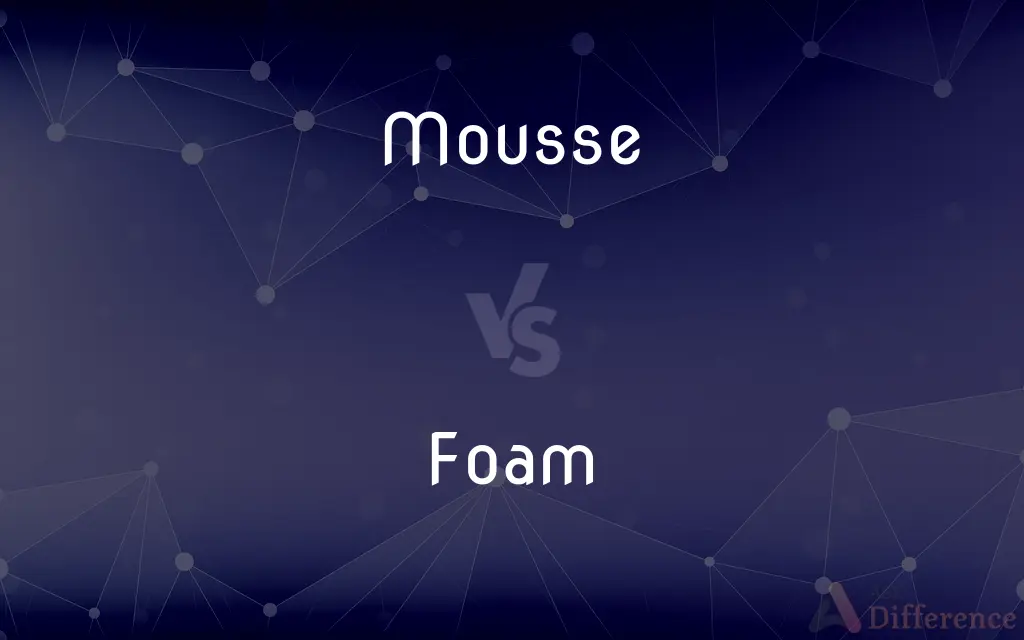Mousse vs. Foam — What's the Difference?
By Urooj Arif & Fiza Rafique — Updated on April 1, 2024
Mousse is rich, airy mixture used in culinary contexts for desserts or hair styling products, emphasizing texture and volume. Foam is broader term describing gaseous dispersion in liquid or solid, found in various application from culinary to industrial.

Difference Between Mousse and Foam
Table of Contents
ADVERTISEMENT
Key Differences
Mousse, in culinary terms, refers to a light, fluffy texture achieved by incorporating air bubbles, usually through whipping cream or egg whites. This technique results in a dessert that is both rich and airy. In hair care, mousse products are used to provide volume and hold without weighing down the hair, maintaining a lightweight texture. The defining characteristic of mousse is its creamy texture and stability, making it ideal for enhancing flavors in foods or achieving desired hairstyles.
Foam encompasses a wider variety of air-in-liquid or air-in-solid mixtures, including everything from shaving foam and foam insulation to the frothy head on a beer. In the culinary world, foams can range from light and ephemeral, like an espresso's crema, to more structured, like a meringue. The key distinction lies in the foam's bubbles: they can be fine or coarse, stable or transient, depending on the substance and the method of creation.
While both mousse and foam incorporate air to achieve a lighter texture, mousse typically aims for a balance between airiness and richness, often with a specific flavor focus in culinary uses. Foam's applications, however, are broader, focusing on the physical properties of the bubbles themselves and their impact on the overall product, whether it be for insulation, cleansing, or aesthetic purposes in food presentation.
In terms of creation, making a mousse usually involves careful folding of air into a base to prevent deflating the mixture, preserving its delicate texture. Creating foam might involve mechanical agitation, chemical reactions, or even pressurized systems to introduce air into a liquid or solid matrix, with less emphasis on maintaining any richness or creaminess.
While mousse in culinary contexts is specifically designed to be consumed and enjoyed for its flavor and texture, foam serves a wider range of purposes that extend beyond eating, from practical applications in construction and grooming to enhancing the visual and tactile qualities of food and beverages.
ADVERTISEMENT
Comparison Chart
Definition
A rich, airy mixture used in foods and hairstyling.
A dispersion of gas in a liquid or solid, with varied applications.
Texture
Creamy and stable, with fine air bubbles.
Can range from fine to coarse bubbles, with variable stability.
Applications
Culinary desserts, hairstyling products.
Culinary, industrial, grooming, and more.
Creation Method
Folding air into a base to maintain texture.
Mechanical agitation, chemical reactions, pressurized systems.
Primary Aim
Balance between airiness and richness, often flavor-focused.
Physical properties of bubbles, broad utility beyond flavor.
Compare with Definitions
Mousse
A light, whipped dessert or styling product.
She topped the cake with a chocolate mousse for added decadence.
Foam
A dispersion of gas in a liquid or solid.
The foam insulation was sprayed into the wall cavities for energy efficiency.
Mousse
Emphasizes a creamy, airy texture.
The mousse added volume to her hair without stiffness.
Foam
Can have fine or coarse bubbles.
The beer's foam added to the overall drinking experience.
Mousse
Aimed at enhancing taste or hair volume.
The strawberry mousse became the highlight of the dessert menu.
Foam
Found in a wide range of applications.
Shaving foam creates a protective layer between skin and razor.
Mousse
Culinary mousse combines flavor with texture.
The lemon mousse offered a perfect balance of tartness and lightness.
Foam
Creation varies by desired outcome.
A hand mixer quickly turned the egg whites into stiff foam.
Mousse
Made by incorporating air into a base.
Folding the whipped cream carefully, he ensured the mousse stayed fluffy.
Foam
Serves purposes beyond culinary uses.
The foam on the cappuccino was artfully crafted into a leaf design.
Mousse
A mousse (; French: [mus]; "foam") is a soft prepared food that incorporates air bubbles to give it a light and airy texture. It can range from light and fluffy to creamy and thick, depending on preparation techniques.
Foam
Foam is an object formed by trapping pockets of gas in a liquid or solid.A bath sponge and the head on a glass of beer are examples of foams. In most foams, the volume of gas is large, with thin films of liquid or solid separating the regions of gas.
Mousse
A sweet or savoury dish made as a smooth, light mass in which the main ingredient is whipped with cream and egg white
Sponge topped with chocolate mousse
A salmon mousse
Foam
A mass of small bubbles formed on or in liquid, typically by agitation or fermentation
A beer with a thick head of foam
Mousse
A mass of tiny bubbles that forms on the top of a glass of champagne or sparkling wine
The Brut Réserve possesses a wonderful creamy mousse of small, compact bubbles
Foam
Form or produce a mass of small bubbles; froth
The sea foamed beneath them
Mousse
A light, foamy preparation used for styling hair
Apply a dollop of volumizing mousse to the roots and work it in towards the ends of your hair
Experiment with different styling products such as mousses and gels
Foam
A colloidal dispersion of a gas in a liquid or solid medium, such as shaving cream, foam rubber, or a substance used to fight fires. A foam may be produced, especially on the surface of a liquid, by agitation or by a chemical reaction, such as fermentation.
Mousse
A frothy brown emulsion of oil and seawater formed by weathering of an oil slick.
Foam
Any of various light, porous, semirigid or spongy materials, usually the solidified form of a liquid full of gas bubbles, used as a building material or for thermal insulation or shock absorption, as in packaging.
Mousse
Style (hair) using mousse
Mousse each section before winding on rollers
His blow-dried and moussed hair
Foam
Frothy saliva produced especially as a result of physical exertion or a pathological condition.
Mousse
Any of various chilled, airy desserts made with flavored whipped cream, gelatin, or eggs
Chocolate mousse.
Foam
The frothy sweat of a horse or other equine animal.
Mousse
A molded dish containing meat, fish, or shellfish combined with whipped cream or egg whites and often gelatin.
Foam
The sea.
Mousse
An aerosol foam used to control and style the hair.
Foam
To produce or issue as foam; froth.
Mousse
To apply a styling foam to (the hair).
Foam
To produce foam from the mouth, as from exertion or a pathological condition.
Mousse
An airy pudding served chilled, particularly chocolate mousse.
Foam
To be extremely angry; rage
Was foaming over the disastrous budget cuts.
Mousse
A savory dish, of meat or seafood, containing gelatin.
Ham mousse
Foam
To teem; seethe
A playground foaming with third graders.
Mousse
A styling cream used for hair.
He slicked his hair back with mousse, but the cowlick still stuck up.
Foam
To cause to produce foam.
Mousse
A stable emulsion of water and oil that is created by wave action churning the water where an oil spill occurs.
Foam
To cause to become foam.
Mousse
To apply mousse (styling cream).
He moussed his hair in the morning and then washed it out at night.
Foam
A substance composed of a large collection of bubbles or their solidified remains, especially:
Mousse
A frozen dessert of a frothy texture, made of sweetened and flavored whipped cream, sometimes with the addition of egg yolks and gelatin. Mousse differs from ice cream in being beaten before - not during - the freezing process.
Foam
A collection of small bubbles created when the surface of a body of water is moved by tides, wind, etc.
Mousse
Any of a variety of foods whipped to a light texture; as, a salmon mousse.
Foam
A collection of small bubbles formed from bodily fluids such as saliva or sweat.
Mousse
A foam containing special chemicals, used for styling hair.
Foam
A collection of small bubbles on the surface of a liquid that is heated, fermented or carbonated.
Mousse
A light creamy dessert set with gelatin
Foam
A collection of small bubbles created by mixing soap with water.
Mousse
A light creamy dish made from fish or meat and set with gelatin
Foam
(firefighting) A collection of small bubbles formed by mixing an extinguishing agent with water, used to cover and extinguish fires.
Mousse
Toiletry consisting of an aerosol foam used in hair styling
Foam
A material formed by trapping pockets of gas in a liquid or solid.
A foam mat can soften a hard seat.
Mousse
Apply a styling gel to;
She mousses her hair
Foam
The sea.
He is in Europe, across the foam.
Foam
Fury.
Foam
(intransitive) To form or emit foam.
Foam
(intransitive) To spew saliva as foam; to foam at the mouth.
Foam
(firefighting) To coat or cover with foam.
It used to be common practice to foam the runway prior to an emergency landing, in case a fuel-fed fire occurred.
Foam
The white substance, consisting of an aggregation of bubbles, which is formed on the surface of liquids, or in the mouth of an animal, by violent agitation or fermentation; froth; spume; scum; as, the foam of the sea.
Foam
To gather foam; to froth; as, the billows foam.
He foameth, and gnasheth with his teeth.
Foam
To form foam, or become filled with foam; - said of a steam boiler when the water is unduly agitated and frothy, as because of chemical action.
Foam
To cause to foam; as, to foam the goblet; also (with out), to throw out with rage or violence, as foam.
Foam
A mass of small bubbles formed in or on a liquid
Foam
A lightweight material in cellular form; made by introducing gas bubbles during manufacture
Foam
Form bubbles;
The boiling soup was frothing
The river was foaming
Sparkling water
Common Curiosities
Can foam be edible?
Yes, certain types of foam, like those made from fruit juices or broths, are designed to be edible and enhance the sensory experience of dishes.
What makes foam in a beer?
The foam in beer, also known as the head, is created by carbon dioxide gas released during fermentation, forming bubbles that rise to the surface.
What is mousse used for?
Mousse is used in culinary applications as a dessert or in hairstyling products to add volume and hold.
How does foam differ from mousse?
Foam is a more general term for gas dispersed in liquid or solid, with applications ranging from industrial to culinary, not necessarily focused on richness or flavor.
Can the texture of a foam be controlled?
Yes, the texture of foam can be controlled through the method of creation, ingredients, and stabilizers to achieve desired coarseness or fineness of bubbles.
Is mousse always sweet?
No, mousse can be savory or sweet, depending on the ingredients used in its preparation.
What role does foam play in grooming products?
In grooming products like shaving foam or mousse, foam acts as a cushion and lubricant to protect the skin and enhance the application of the product.
Why is mousse popular in desserts?
Mousse is popular in desserts for its light, airy texture that offers a rich yet delicate eating experience, balancing flavor and mouthfeel.
Are all foams lightweight?
While many foams are lightweight due to their air content, the density can vary based on the medium and the amount of gas incorporated.
How do you make a culinary mousse?
A culinary mousse is made by folding whipped cream or beaten egg whites into a flavored base, carefully incorporating air to maintain a fluffy texture.
Share Your Discovery

Previous Comparison
Trucking vs. Hauling
Next Comparison
Kielbasa vs. LinguicaAuthor Spotlight
Written by
Urooj ArifUrooj is a skilled content writer at Ask Difference, known for her exceptional ability to simplify complex topics into engaging and informative content. With a passion for research and a flair for clear, concise writing, she consistently delivers articles that resonate with our diverse audience.
Co-written by
Fiza RafiqueFiza Rafique is a skilled content writer at AskDifference.com, where she meticulously refines and enhances written pieces. Drawing from her vast editorial expertise, Fiza ensures clarity, accuracy, and precision in every article. Passionate about language, she continually seeks to elevate the quality of content for readers worldwide.














































